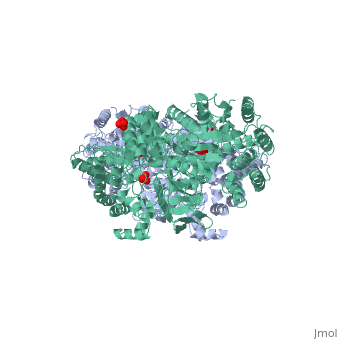1dik
From Proteopedia
PYRUVATE PHOSPHATE DIKINASE
Structural highlights
Function[PPDK_CLOSY] Catalyzes the reversible phosphorylation of pyruvate and phosphate. In E.histolytica and C.symbiosus, PPDK functions in the direction of ATP synthesis. Evolutionary ConservationCheck, as determined by ConSurfDB. You may read the explanation of the method and the full data available from ConSurf. Publication Abstract from PubMedThe crystal structure of pyruvate phosphate dikinase, a histidyl multiphosphotransfer enzyme that synthesizes adenosine triphosphate, reveals a three-domain molecule in which the phosphohistidine domain is flanked by the nucleotide and the phosphoenolpyruvate/pyruvate domains, with the two substrate binding sites approximately 45 angstroms apart. The modes of substrate binding have been deduced by analogy to D-Ala-D-Ala ligase and to pyruvate kinase. Coupling between the two remote active sites is facilitated by two conformational states of the phosphohistidine domain. While the crystal structure represents the state of interaction with the nucleotide, the second state is achieved by swiveling around two flexible peptide linkers. This dramatic conformational transition brings the phosphocarrier residue in close proximity to phosphoenolpyruvate/pyruvate. The swiveling-domain paradigm provides an effective mechanism for communication in complex multidomain/multiactive site proteins. Swiveling-domain mechanism for enzymatic phosphotransfer between remote reaction sites.,Herzberg O, Chen CC, Kapadia G, McGuire M, Carroll LJ, Noh SJ, Dunaway-Mariano D Proc Natl Acad Sci U S A. 1996 Apr 2;93(7):2652-7. PMID:8610096[1] From MEDLINE®/PubMed®, a database of the U.S. National Library of Medicine. See AlsoReferences | ||||||||||||||||||||||||


